Unit 1: The Global Tapestry
Topic 1.1: Developments in East Asia
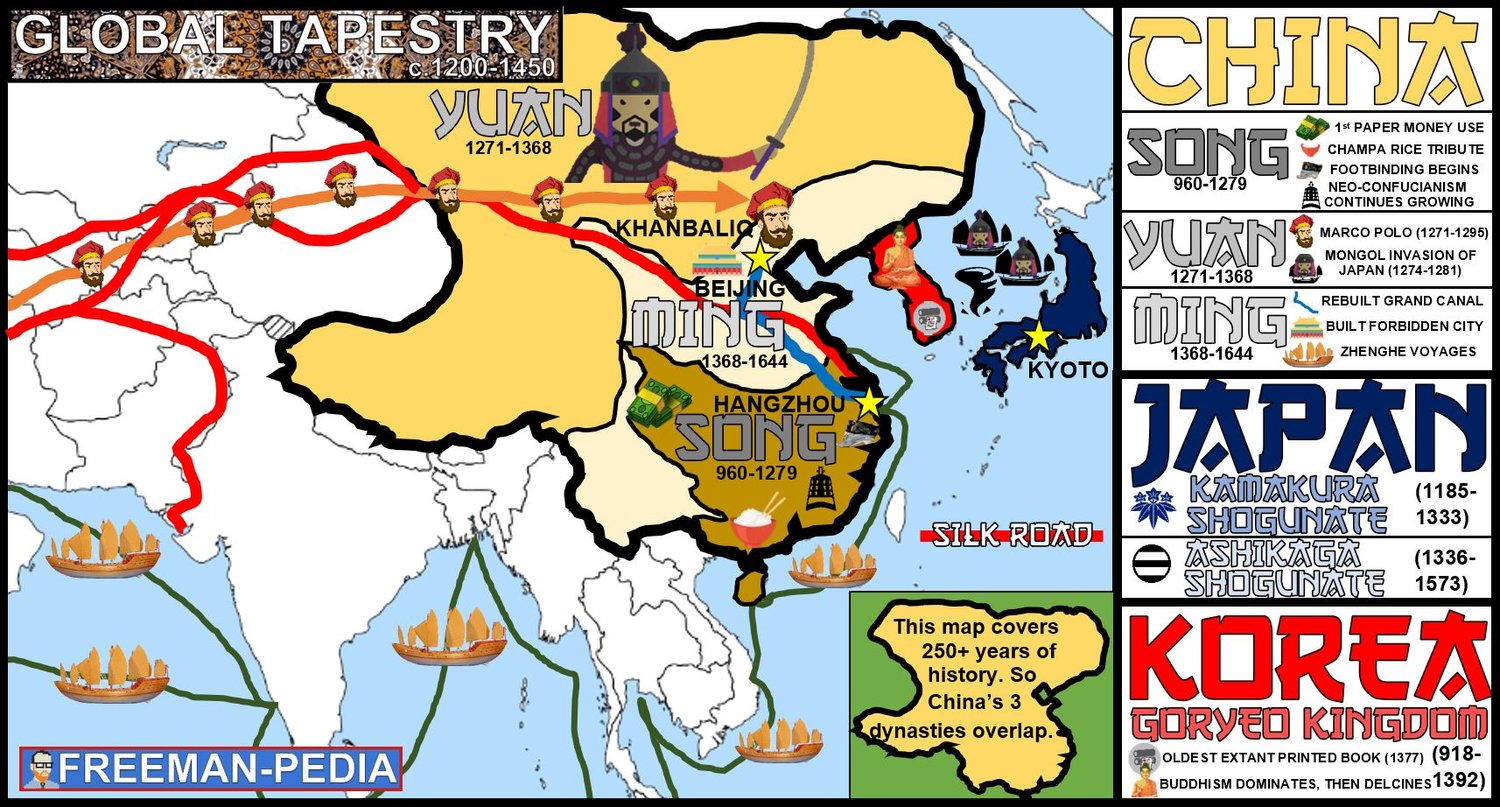
Cycle of Dynasties
A new dynasty comes to power, the dynasty governs well, government corruption increases, famine and natural disasters cause suffering among commoners, the commoners revolt, the current emperor is defeated and the Mandate of Heaven is considered lost, so a new dynasty comes to power. This repeats.
Song Dynasty (960-1279)
At this point, China has 7000 years of history. Korea is a tribute state to China at this time. This was an oath of allegiance, and a payment of either money or people. Does this with nomadic tribes as well. The Song Dynasty becomes really powerful because of technological innovations, and conquering parts of Vietnam. Champa rice came from Vietnam, and became a statement in China. Has large drought tolerance, double growing season.
Yuan Dynasty (Mongols) (1271-1369)
In 1271, the Mongols start conquering East Asia. In 1278, they fully conquer China. Kublai Khan sets up a dynasty in China, under the Yuan dynasty. Causes peace along the Silk Road for the next 100 years, leading to more money coming into China.
Ming Dynasty (1369-1644)
The largest of the Chinese people are the Han, and they become tired of the Yuan dynasty, overthrow them, and become the Ming dynasty. Changes from a land based power to a maritime based power. Massive trade on the Indian Ocean. Then one of them decided to stop, and this hurts China.
China used Religion to Help Rule
This was through the Mandate of Heaven and Confucian Scholars. The Chinese belief that the gods have chosen the emperor to be the emperor, and when there is a major disaster, there is a moral obligation for him to lose his right to govern. Confucianism was China’s primary belief system and shaped the government
China used Bureaucracy to help Rule
The Chinese empower oversaw an organized and complex government system built around ministries that managed the work of the Chinese State for the emperor. This was similar to the current US government, with the Department of Education, etc. The Song dynasty tried to make a meritocracy, where the government jobs took the Imperial Exam, which decided who was qualified to work in the Government. This test was based on merits and the Confucian religion. It was not equal as it was intended because the rich had more money to pay for better study tools.
China used the Tribute System to Help Rule
Required foreigners and parts of the kingdom to swear allegiance to the country through giving money, allegiance, or people. Many of these were on the Silk Road. Vietnam was also a tributary state. Nomads, Korea, Japan, etc. They brought some kind of payment, provided gift to the emperor and state, and they met with the emperor and bowed at his feet to show respect. China also had many powerful neighbors, so they paid those people to give them right of way for merchants, and also to not attack them.
Topic 1.2: Developments in Dar al-Islam
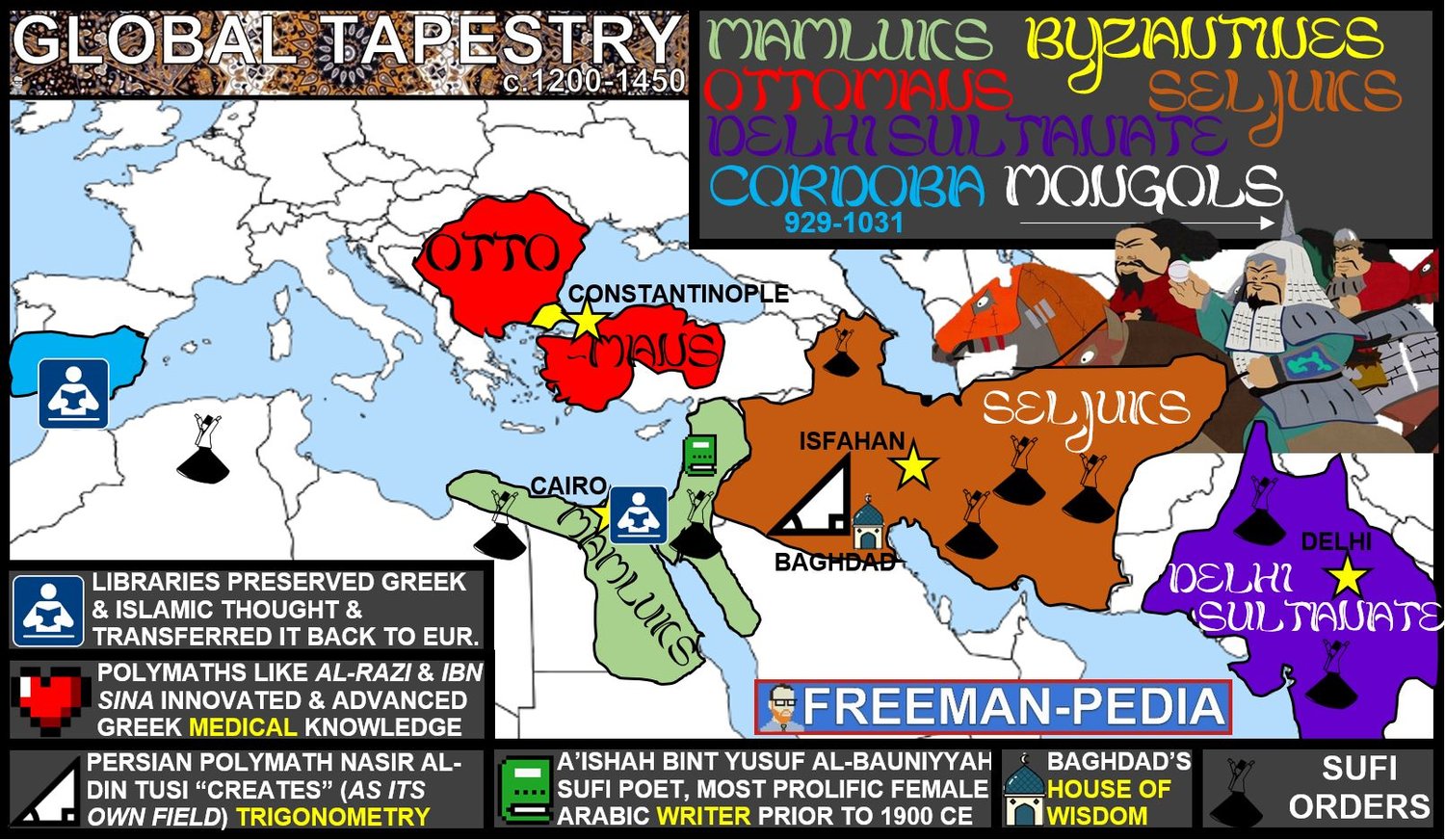
Dar al-Islam an Islamic term that means 'house of Islam' and refers to the dominion of Islam in different regions of the world often considered a "Golden Age"
BEFORE 1200
In the 600s, Muhammed, a merchant, lives in Mecca, and he has a dream where God tells him who he is (a prophet). The people of Mecca chase him out, and he goes to Medina. The people of Medina are more reciprocal to Islam. He recruits their army, and takes over Mecca, and spreads Islam. Shia believe the nephew should replacement. They live in Iraq and Iran. Sunni live everywhere else.
Umayyad Dynasty
Established their capital in Damascus, which allowed better control over the vast Islamic Empire. They conquered parts of the Byzantine Empire, and created a dynasty which solved the succession issues. Tightly centralized rule that showed favor to Arabs or administrative issues. Ruled Dar al-Islam as conquerors, with Arab military aristocracy (Members of elite selected as governments of conquered lands). Incredibly diverse, allows for Christians, Jews, Zoroastrians, etc. People of the book could follow any religion. People of the book had to pay a jizya (special tax) if they did not convert to Islam. Polytheism was not allowed. Some positions of wealth and authority reserved for Arab Muslims. Declined in the 8th century as they devoted themselves to luxury.
800s-1300s
The Abbasid’s perform a coup, and overthrow the Umayyad’s in all but Spain. The Abbasid Caliphates move the capital to Baghdad and control more of the Middle East. They change the court system, judges are elected to judge based on the Sharia law. They build the house of wisdom, which is the grand library of Baghdad, which has thousands of books. The elite scholars come to learn there. This leads to intellectual innovation.
Sufis
Islam spreads through military, merchants, and Sufis. Sufis are mystic, Muslim missionaries. Have a deeper relationship with Allah. They tell people how to be closer to God, such as the 5 pillars of Islam. They spread Islam to places such as Indonesia and Pakistan.
The Abbasids start falling apart because they borrowed soldiers from other places. New political entities of Islam form: Seljuk Empire in Persia, Mamluk sultanate of Egypt, and Delhi sultanates in North India.
Delhi Sultanates
Convert people in the region that have Turkish tongue to Islam through merchant interaction. They then raid into India for their horses and jewels. Destroy sacred sites, and move rule from Kabul, Afghanistan to Delhi. Form sultanate (group that rules with a sultan as their leader).
Seljuk Empire
Military group of Turkish tribes. Learn Persian culture. Came to restore Muslim unity under the Sunni caliphate. Network of colleges to give uniform training to administrators and religious scholars.
Mamluk Sultanate of Egypt
Ruled by military caste of Mamluks, means owned slave. Granted partial freedom after military time. Headed by the Sultan. Sultan died, they do not feel loyalty to the new Sultan.
al-Andalus
Islamic Spain is known as al-Andalus. Governors of al-Andalus were Umayyads who refused to recognize the Abbasid Dynasty. Still participated with trade with the rest of the Islamic world. Trade allowed for imported crops and increased the food supply.
Trade Networks
Umayyad and Abbasid Empires created huge zones of trade, exchange, and communication stretching from Indian to Iberia (Spain/Portugal).
Social Changes for Women
Arab women could legally inherit property, divorce husbands, engage in business ventures. The Quran outlawed female infanticide (kill the female baby after birth), provided dowries go directly to women, and portrayed women as equal and honorable, not as property. Still recognized descent through the male line. Veiling of women is a long-standing custom (Burkas and Hijabs).
Advances in mathematics (Nasir al-Din al-Tusi made trigonometry), Advances in literature ('A'ishah al-Ba'uniyyah made poems about relationships with Allah), Advances in medicine.
Topic 1.3: Developments in South and Southeast Asia
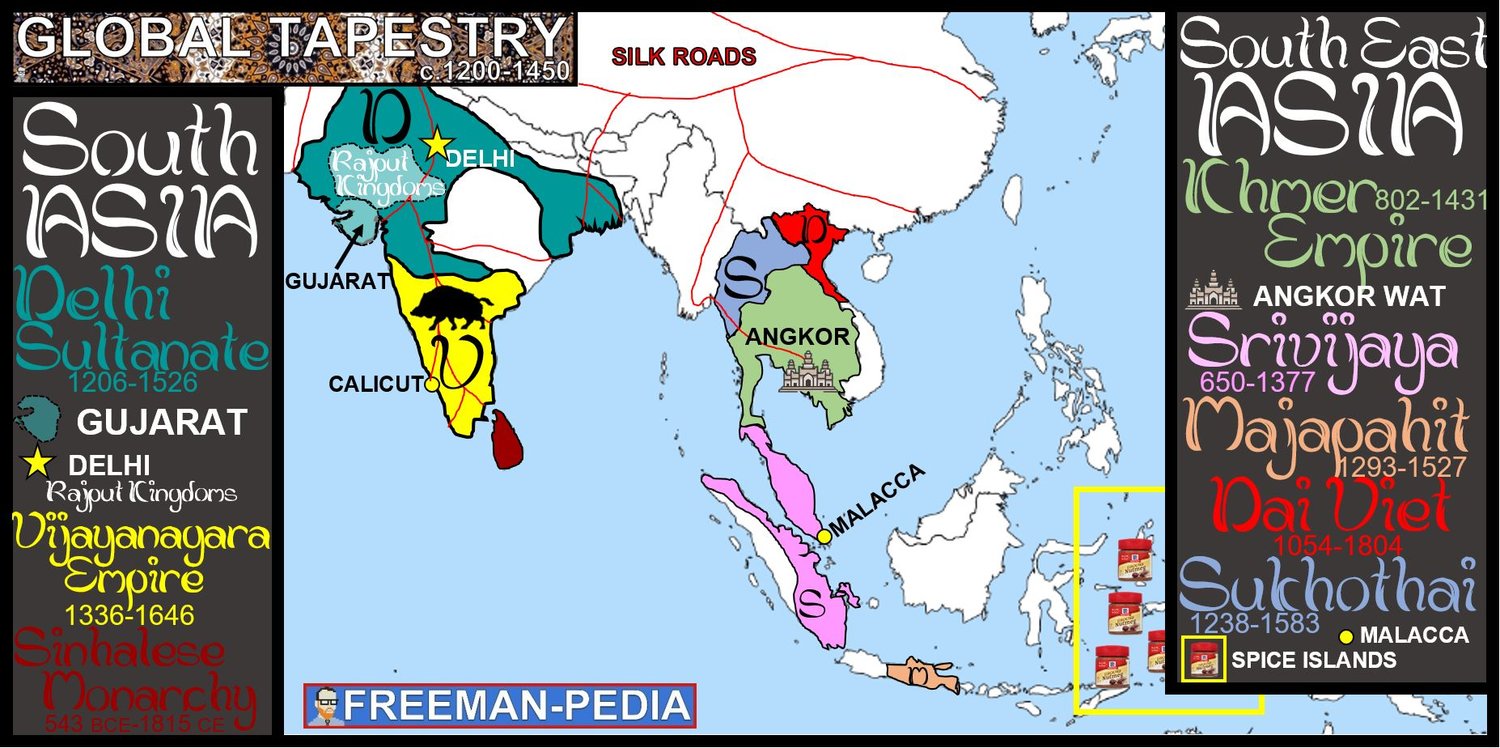
Hinduism - The Bhakti Movement
Sought to make Indian society more tolerant of religious diversity. Bhakti followers believed that all castes were equal in God’s eyes and equal on earth. Spirituality and worship of God mattered, not whether one prayed to Shiva or Allah. The Bhakti movement was mostly poets.
Examples: Majapahit in the Indonesian Archipelago and Malay Peninsula, is a Hindu Monastery
Buddhist Monasticism
As Buddhism transferred along the Silk Road to East Asia, Buddhist monks and nuns set up monasteries along trade routes. Wealthy traders and merchants who had converted to Buddhism helped finance Buddhist temples and monasteries. Buddhism replaced Hinduism as the dominant religion in Southeast Asia mainland (Cambodia, Myanmar, Thailand, and Vietnam)
Examples: Srivijaya in the Indonesian Archipelago and Malay Peninsula, is a Buddhist Monastery, Khmer in Laos, Cambodia, and Thailand is a Hindu Monastery that converted to a Buddhist Monastery, and Sukhothai in Thailand is a Buddhist Monastery
Islam - Merchants and Missionaries
The Islamic Mughal Empire replaced the Delhi Sultanate. Islam was most dominant in North India. The Expansion of Islam in Southeast Asia was primarily on the Malay peninsula and the islands. Islam’s entry into Southeast Asia was primarily a result of merchants who moved to the area for economic opportunity. Initially, Islam was a religion of the wealthy and ruling classes. Over time, the religion spread to the masses. Partially through the work of Sufi missionaries.
Examples: The Sultanate of Malacca in the Malay Peninsula was an Islamic Monastery
Topic 1.5: State Building in Africa
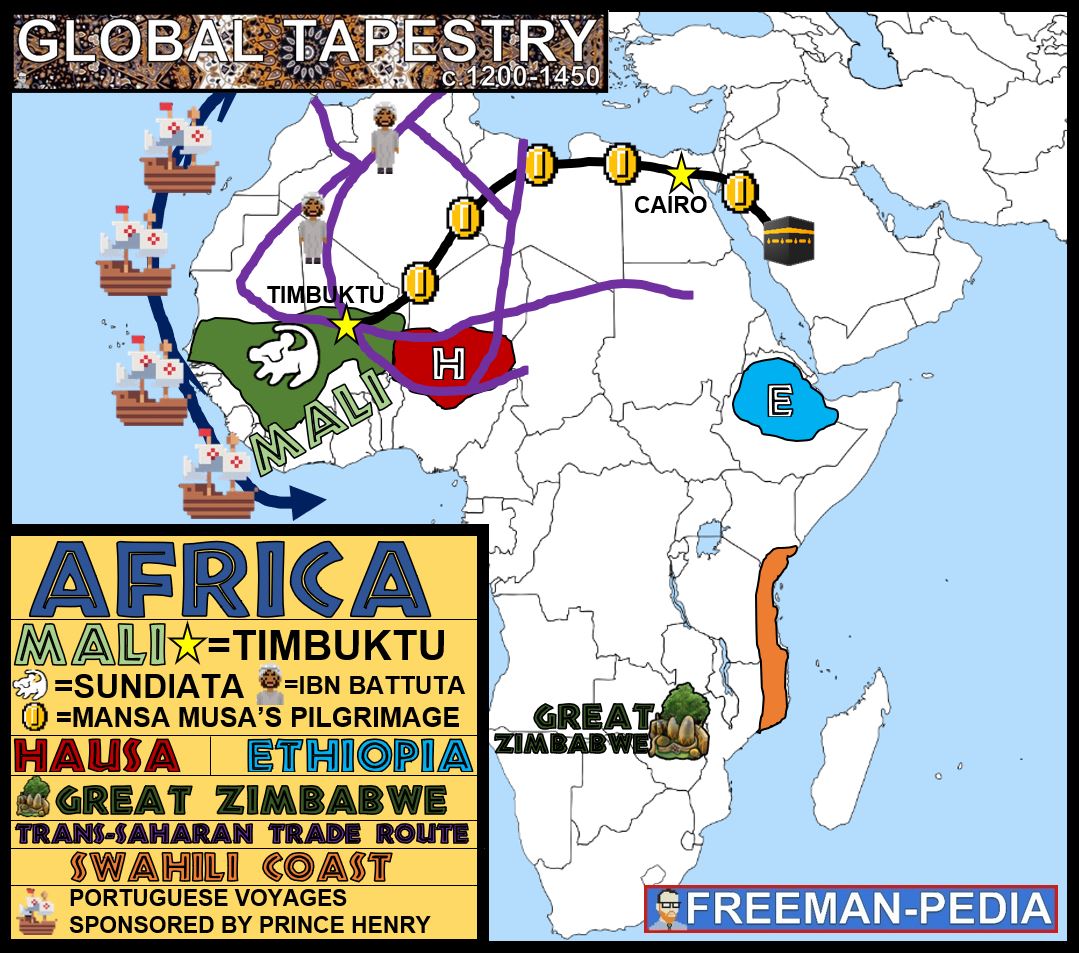
Swahili States (Orange on the map)
Called that because they speak Swahili, lingua franca of East Africa. Comes from Arabic, because of Arabian trade routes. They also bring the religion of Islam to East Africa. Go from animism to Islam. Decentralized governments based on tribal chiefdoms.
Great Zimbabwe
Has access to gold, silver, trees, salt, slaves, and costal routes. This makes it so that people can trade for all these resources. They make a rock castle in the Great Zimbabwe. Becomes Islamic through merchants.
Ethiopia
Stays Christian instead of converting to Islam, because that is where the bible originated. Ethiopia and Mali have a lot of salt fields. Coffee originated here. Arabic trades traded for the coffee, and Dar al-Islam takes it to Indonesia and Spain. Spain eventually takes it to South America. Centralized government. Monarchy with a king.
Hausa Kingdoms (Red)
Independent tribal leaders who act as a federation. Decentralized like Swahili kingdoms. Wealthy because of trade along the Trans-Saharan trade routes (purple). Went from animism to Islam through trade.
Mali (green)
Kingdom ruled by a king with central government.
Topic 1.6: Developments in Europe
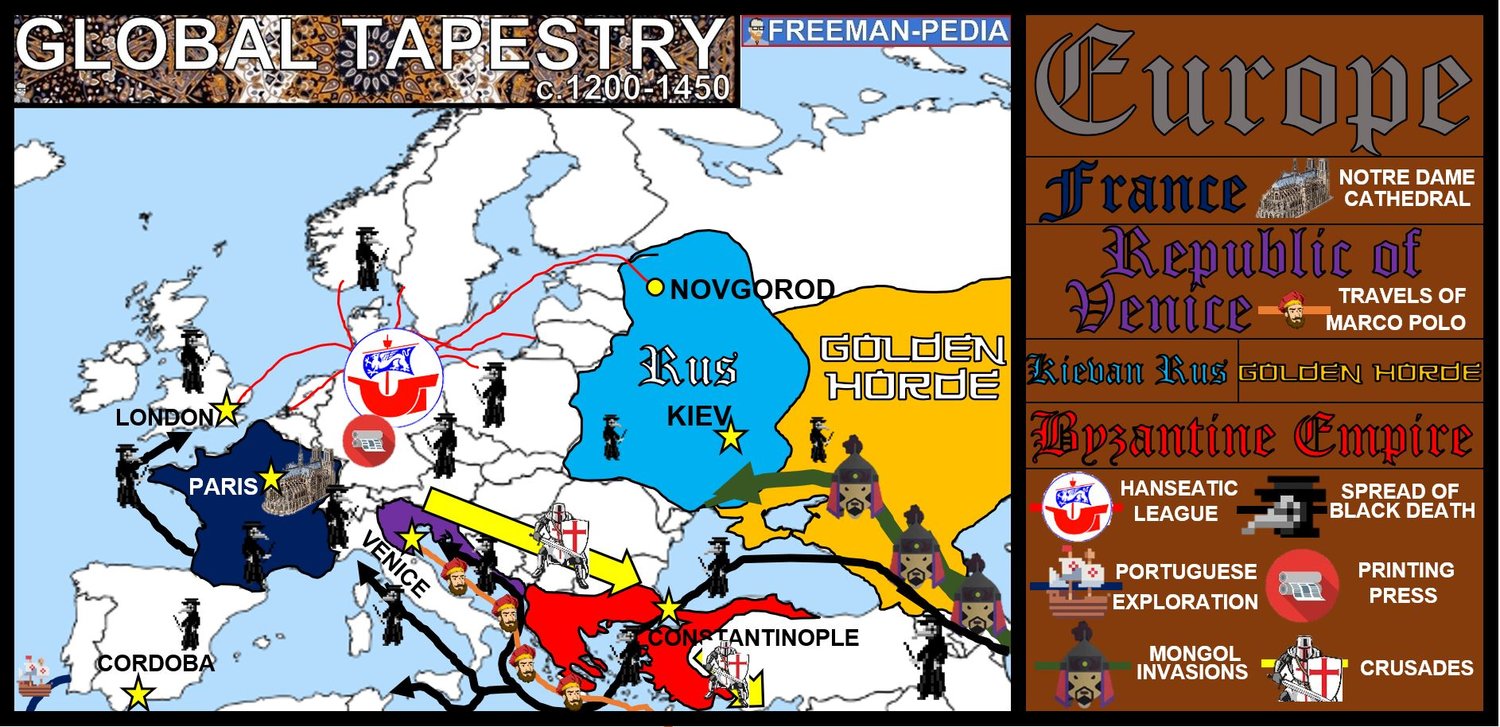
End of the Roman Empire
Fell in 476. West Europe started Medieval Period (Dark ages) Trade goes away, so not much is coming into Europe during this period. Intellectual life receded. Roman state replaced by smaller kingdoms, and fought with one another to control territory. Roman Catholic Church remained powerful in most of Europe unitl 16th century. Learning and trade began to revive between 1000-1450 because people moved to cities (High Middle Ages).
Feudalism
Europe had a decentralized political system. Feudalism is the exchange of land for loyalty. Without a strong government, there are bandits, rival lords, and invaders such as the Vikings, and people need protection. So the monarch owns all the land, and he gives portions of the lands (fiefs) to his lords, who swear alliegance to him. They back him because they have knights that owe service (vassels). The poor people have vassels to the knights, so they work on the land for the knights, who works for the lords, who works for the king. The power rests in whoever owns the land, because that can be used for farming. Based on agricultual wealth, which was measured in land. If you do not have land, your social structure goes down, and vice versa.
Manorial System
Large fiefs or estates were refered to as manors. Manorial system provides economic self-sufficiency. Manor produces everything that the people living on it required. Serfs, while not slaves, were tied to the land. Manors had villages, churches, etc. Cannot travel or marry without permission by the lord. Debt to the lord is paid off by crop production. Children born to serfs also became serfs, and they get their father’s debt.
Changes to Agriculture
Becomes more efficient due to new technology such as windmills and plows. The three-field system, in which crops were rotated through three fields. One field has wheat or rye, which provided food. Second field has legumes, which made the soil fertile by adding nitrogen to it. Third field was unused each year. These fields were rotated out each year, making it more efficient.
Enviromnmental Issues
There are several plagues that strike during this time. The Bubonic plague killed one-third of the population. This causes a growing demand for labor due to deaths. This gives serfs more bargaining power with lords. Urban growth was hampered after 1300 by a five-century cooling of the climate known as the Little Ice Age.
Lower temperatures also reduced agricultural productivity. People had less to trade, and cities grew more slowly. The Little Ice Age led to an increace in disease and an increase of unemployment. Created social unrest, and crime rates increased. Jews and Muslims were used as scapegoats, and were blamed for this even though they couldn’t do anything. This is because they had restrictions on cleanliness by their religion, which helped them not get sick. Poeple resented them for this, and thought they were witches and warlocks, and burned them at the stake. This went on until the Ottoman Empire took them into their original homeland of Israel, Palestine, and Turkey.
Social Change
Rural residents began to move to towns and cities for better economic opportunities than manors. They joined guilds, an association of artisans and merchants who oversee the practice of their craft in a particular area. Merchants had guilds that hold a monopoly on their artisan craft. This made guilds economically and politically powerful. Rises standard of living to those of the lords.